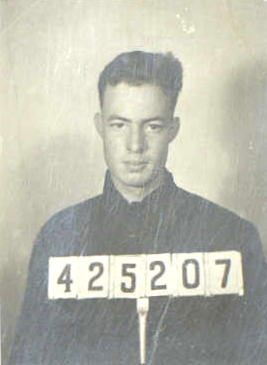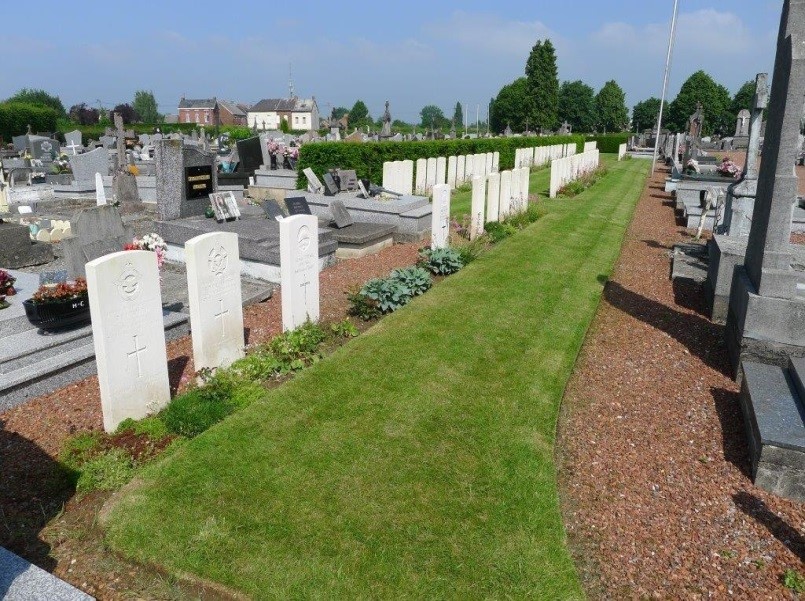Flight Sergeant Austin Hardcastle Palfreyman, the son of Frederic Godfrey Palfreyman and Marjorie Therese Palfreyman (nee Cotton), was born at Townsville in Queensland on 4th September 1921. He was educated at the Church of England Preparatory School in Toowoomba during the years 1933 – 1936 and he then attended the Toowoomba Grammar School where he completed the Junior Public Examination in 1938. He applied for aircrew training in the Royal Australian Air Force on 18th June 1941. He had no previous military experience. At the time of his application he was unmarried, employed as a Station Jackeroo at “Burnside”, Corfield, via Winton. He was enrolled in the Reserve of the R.A.A.F. on 8th August 1941 after swearing the statutory oath of allegiance and he was issued with Reserve Badge 2520. At the age of 20 years and 4 months he was enlisted into the Citizen Air Force of the R.A.A.F. at No. 3 Recruiting Centre in Brisbane on 31st January 1942 after giving a commitment that he would serve for the duration of the war and an additional twelve months. His physical description at the time of enlistment was that he was 6 feet in height and weighed 145 pounds. He had a fair complexion, brown eyes and dark brown hair. He stated that he was of the Church of England religion. He gave his next of kin as his mother, Mrs Marjorie Palfreyman, 304-306 Queen Street, Brisbane.
Flight Sergeant Austin Palfreyman was allotted the service number of 425207. He joined No. 3 Initial Training School at Kingaroy in Queensland on 31st January 1942. He joined No. 1 Air Observer School at Cootamundra in New South Wales on 26th June 1942. He joined No. 1 Bombing & Gunnery School at Evans Head in New South Wales on 16th October 1942. After completing his course at Evans Head he was awarded the Air Observer Qualification Badge. He joined No. 1 Air Navigation School at Parkes in New South Wales on 12th December 1942. After completing his training at Parkes he was promoted to the rank of Temporary Sergeant on 4th February 1943.
Flight Sergeant Austin Palfreyman joined No. 3 Embarkation Depot at Sandgate in Queensland on 5th February 1943 and then joined No. 1 Embarkation Depot at Ascot Vale in Melbourne on 25th February 1943 to prepare for overseas service on attachment to the Royal Air Force. He embarked from Melbourne on 6th March 1943 and disembarked in England on 17th April 1943. He joined No. 11 Personnel Despatch & Reception Centre at Bournemouth on 18th April 1943. He joined No. 4 (Observer) Advanced Flying Unit at Royal Air Force Station West Freugh on 21st June 1943. He joined No. 27 Operational Training Unit at Royal Air Force Station Lichfield on 20th July 1943. He was promoted to the rank of Temporary Flight Sergeant on 7th July 1943. He joined No. 1667 Conversion Unit on 16th October 1943. He joined No. 460 Squadron Royal Australian Air Force at Royal Air Force Station Binbrook for operational duty on 25th January 1944.
Flight Sergeant Austin Palfreyman was an Air Observer and crew member of a No. 460 Squadron Royal Australian Air Force Lancaster ND586 that went missing during air operations on 10th April 1944. The aircraft had been detailed to attack the Aulnoye Marshalling Yards in France. The Commanding Officer of No. 460 Squadron wrote the following letter to his mother on 14th April 1944:
Dear Mrs Palfreyman, Before you receive this letter you will have been notified by the Air Board, Melbourne, that your son, AUS.425237 Flight Sergeant A.H. Palfreyman was reported missing whilst engaged on an operational flight from this country. It is with deep regret that I am writing to confirm this unhappy news and to let you know something of the circumstances under which your son was reported missing. On the night of 10th April 1944 he took off to carry out bombing operations against Aulnoye. Unfortunately no further news was received concerning the fate of the aircraft or any members of the crew after they took off at 23.41 hours.
The loss of Flight Sergeant Palfreyman has deprived the squadron of an Air Bomber of great promise whose characteristic skill and courage were an inspiration to us all and on behalf of all the members of the squadron, I should like to convey to you our sincere sympathy. May I again express my sincere personal sympathy and the hope that some news may yet be received of your son’s ultimate safety. Yours sincerely, H.D. Marsh, Officer Commanding.
Among his personal effects were 7 unposted letters addressed as follows:
Miss N. McKelvie, Brisbane, Queensland. (3 letters)
Mrs Palfreyman, Southport, Queensland. (2 letters)
Miss M. Florence, Cootamundra, New South Wales. (1 letter)
Mrs E. Craney, Blackall, Queensland. (1 letter)
On 7th November 1944 his mother was advised that information from German sources received by the International Red Cross Committee in Switzerland that Austin Palfreyman and the remainder of the crew lost their lives. The report added that Austin Palfreyman was buried in the Parish Cemetery, Maubeuge, Nord, France, Grave No. 55.
The following report was furnished by an unnamed French official who went to the scene of the crash in the afternoon of the day that it crashed gives an account of the retrieval and burial of the crew:
At the request of the Denain Luftwaffe authorities I went to the scene of the crash at 1700 hours on the 11th April 1944, accompanied by German soldiers, in order to try and identify the victims. At a distance of about 200 metres from the aircraft I found the body of Lieutenant Riaz which had escaped the fire caused by the explosion of the aircraft. I have to state the sad fact that the body had been rifled by evil doers. His watch, his money and probably his identity disc had been stolen. I discovered the name Riaz inside his boots and conclude this was his name. In the vicinity of the aircraft a sad sight greeted me as the bodies of all of the other occupants had been charred. I found nothing to identify the body of the second airman examined, as all his clothing had been burnt. The same thing had happened in the case of the third airman, but his identity disc was still on his neck. He was W.G. Hogg of the R.A.A.F.
At this point night fell and I asked that the work of identification should be suspended until next morning. At dawn I was surprised to find five of the bodies placed in coffins, the soldiers having placed a further two in coffins after my departure. These two airmen were MacDougall and a Sergeant who wore the badge of a machine gunner. I do not know what happened to the personal effects of the last two named. The bodies were taken to Maubeuge and buried in the British section of the cemetery on the 12th April. These graves are numbered as follows:
- No. 54 Lieutenant K.R. Riaz.
- No. 55 Unidentified.
- No. 56 W.G. Hogg 429322, R.A.A.F.
- No. 57 MacDougall 410699, R.A.A.F.
- No. 58 Sergeant Machine Gunner.
The French pastor conducted the burial service which was a very simple one. The municipality was represented by M.M. Bavais, the Thirict. No Germans were present and the police whom I had summoned had no occasion to take any action. But other bodies had remained under the wreckage and on 14th April at 0800 hours I was notified that the local police of Vieux Mesnil had found three young men in the act of searching the body of an airman which they had recovered from the wreckage, taking advantage of the lack of any guards. It was very fortunate that the police had intervened as the young men had in their possession the only means of identifying the dead man. This was a wrist watch marked A.H. Probert – R.A.A.F. From the remnants of his jacket I was able to discover that his rank was that of a Lieutenant. The watch, money, and a signet ring which constituted his personal effects were sent in a sealed envelope to the Luftwaffe at Denain.
On the lower part of the body in the pockets of the seventh member of the crew, who had been pinned under the wreckage, a purse and a small cylindrical lighter were found. Someone present at the time informed me that his pocket book was in the possession of an inhabitant of Neuf-Mesnil. Equipped with this information, I went to this village and was fortunate enough to recover the pocket book. In it and among other papers, was a leave pass in the name of Sergeant Davies Robbins, which I presume was the airman’s name. The bodies were placed in coffins and taken to Maubeuge where they were buried in the British section of the cemetery at 0900 hours on 17th April. Their graves are numbered as follows:
- No. 59 Lieutenant A.H. Probert
- No. 60 Sergeant Davies Robbins
In accordance with orders received from the K.K. the pastor was not asked to take the service, and for the first time I was the only person present. Neither the police nor representatives of the municipality were present. On 16th April, I was informed that the persons who had searched the bodies resided at Hautemont and that they were in possession of personal effects belonging to the deceased. I notified the Gendarmerie of the town by telephone, asking them to institute an enquiry and try and retrieve the dead airmen’s personal effects.
Exhumations carried out at the Communal Cemetery at Maubeuge by No. Missing Research & Enquiry Unit after the war confirmed that Flight Sergeant A.H. Palfreyman was buried in Grave 55 and the identification of all members of the crew was confirmed.
Sergeant Austin Palfreyman was on his 14th air operation when he was killed. It included 2 to Berlin; 1 to Leipzig, 1 to Boulogne, 2 to Stutgart, 3 to Frankfurt, 1 to Augsberg, 1 to Essen, 1 to Danzig and 1 to Nuremberg.
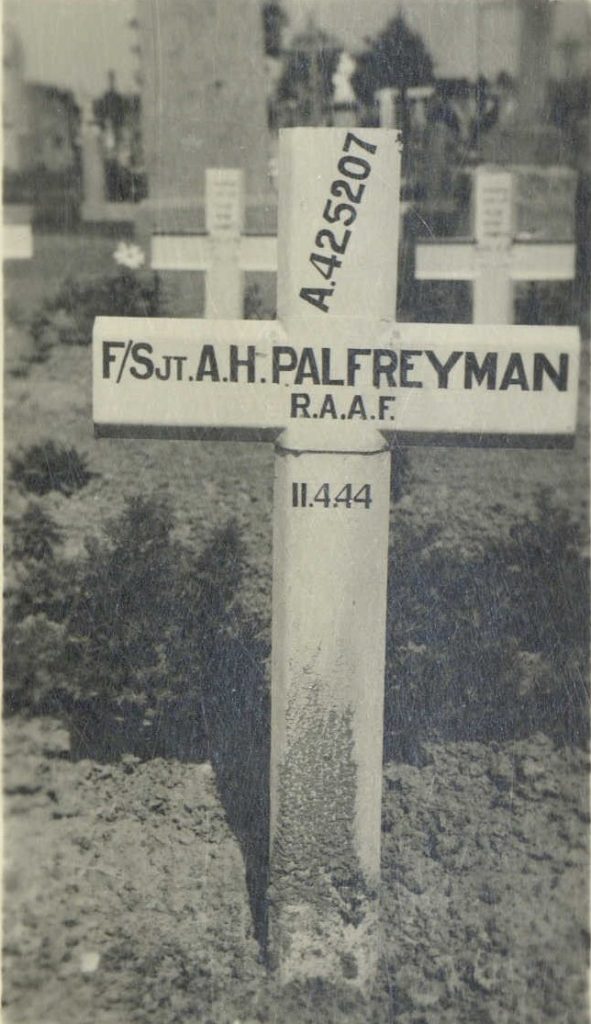
Photo: Temporary headstone placed over his grave in the Maubeuge-Centre Cemetery.
At the time of his death Austin Palfreyman was 22 years of age. His headstone in the Maubeuge-Centre Cemetery contains the family inscription “Dawn Was Theirs, And Sunset, And The Colours Of The Earth”. Flight Sergeant Austin Palfreyman, for his service during World War 2 was awarded the Air Observer Qualification Badge, the 1939/1945 Star, the Aircrew Europe Star, the Defence Medal, the War Medal and the Australian Service Medal 1939/1945. His name is commemorated on Panel No. 98 at the Australian War Memorial in Canberra, Chinchilla War Memorial and locally on the Toowoomba Grammar School World War 2 Honour Board.
Toowoomba Grammar School archive records show that he enrolled as a student on 31st January 1937 and left the school on 3rd December 1937.
External Links
Australian War Memorial Honour Roll
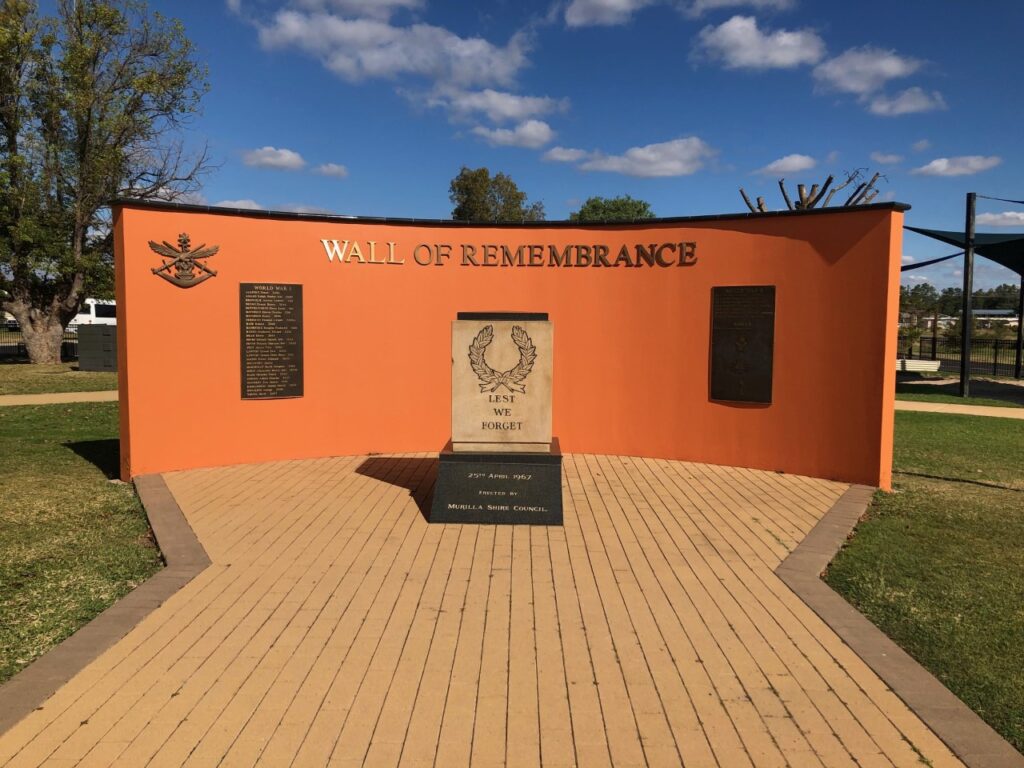
Chinchilla War Memorial
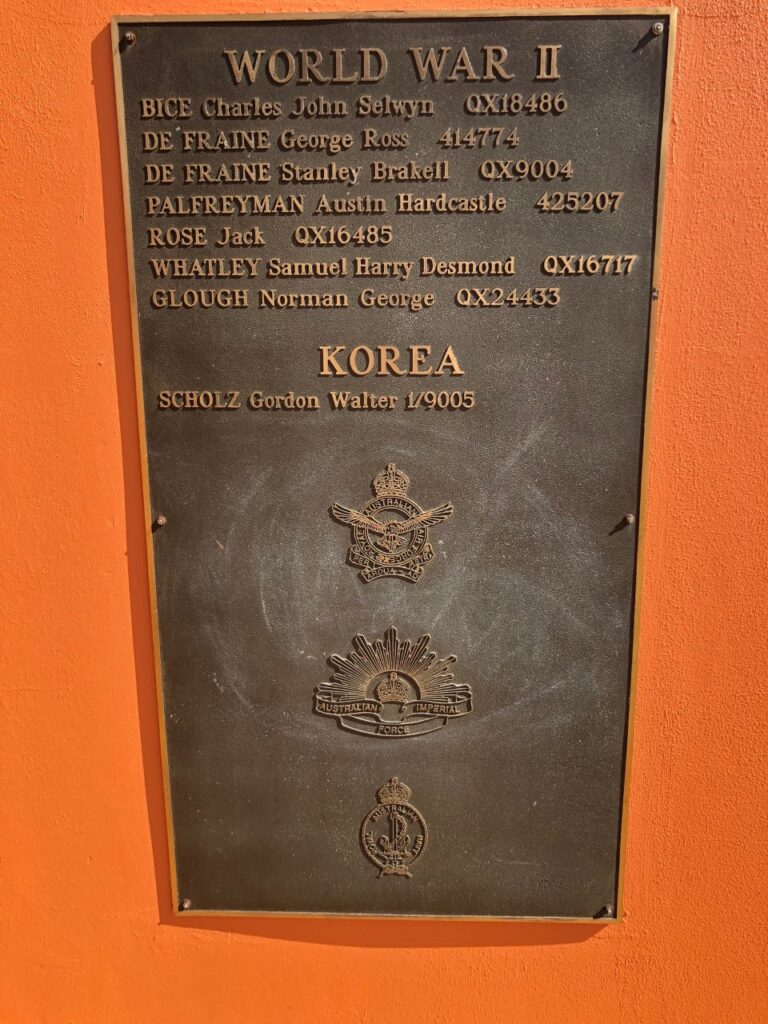
Chinchilla War Memorial – Those that paid the Supreme Sacrifice


